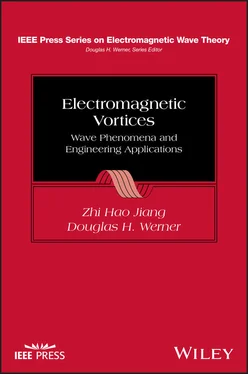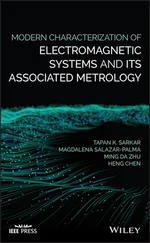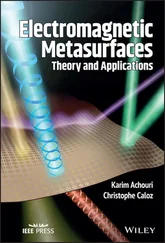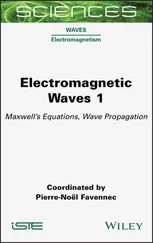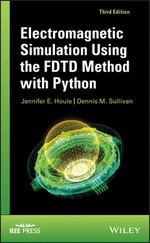1 ...7 8 9 11 12 13 ...18 (1.9) 
which describes a spherical wavefront. The gradient of the wavefront gives the direction of the wavevector (i.e. the geometrical optics ray direction):
(1.10) 
For the Laguerre–Gaussian beam, the far‐field signature of the vortex phase is a cone‐shaped pattern with an amplitude null at the center. The locus of the points with constant phase in the far‐field can be found from Eq. (1.6)and is described by the following equation:
(1.11) 
which describes a twisted wavefront, as shown in Figure 1.5. Note that the first term is frequency dependent similar to Eq. (1.10). The gradient of the wavefront (i.e. the wavevector direction) is:
(1.12) 
Unlike the wavevector of the Airy disk, the wavevector of a Laguerre–Gaussian beam has a radial and azimuthal component. Note that for very large distances compared to the wavelength ( k 0 r → ∞),
(1.13) 
In other words, the wavefront of a Laguerre–Gaussian modes at very large distances compared to the wavelength, i.e. in the very far‐field, resembles a spherical wavefront, as shown in Figure 1.5.
An immediately remarkable trait of the cone‐shaped far‐field pattern is the reduced directivity compared to the conventional beam counterpart. The Airy disk pattern is a highly directive far‐field pattern with 100% aperture efficiency. A Laguerre–Gaussian mode with l = 1, aperture diameter D , and beam waist w g= 0.415 D has an aperture efficiency of 50%. As a result, an antenna with an aperture that is twice as large compared to the conventional counterpart is required to maintain the same directivity level. Figure 1.6shows the directivity of the Airy disk pattern and the first‐order Laguerre–Gaussian beam for D = 4λ and w g= 0.415 D , normalized to the maximum directivity of the Airy disk pattern. The directivity of the Laguerre–Gaussian beam is 3 dB less than the Airy disk pattern of the same aperture size. Another distinctive characteristic is the beam divergence; the larger the OAM mode number, the larger the cone angle of the beam. That is, higher‐order OAM modes diverge more rapidly with propagating distance.

Figure 1.5 Far‐field wavefront of (a) Airy disk and (b, c) Laguerre–Gaussian modes. The wavefront of the Airy disk is spherical and the wavefront of Laguerre–Gaussian modes is twisted; (c) at very large distances compared to the wavelength ( k 0 r → ∞), the wavefront of Laguerre–Gaussian approaches a spherical wavefront.
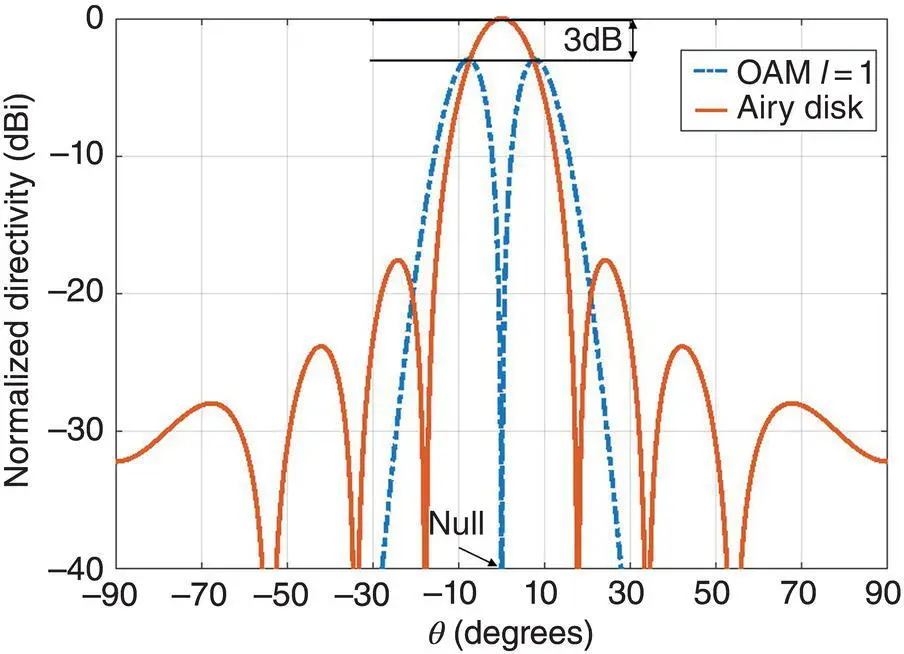
Figure 1.6 Normalized directivities of the Airy disk pattern with aperture diameter D = 4λ and the Laguerre–Gaussian mode with mode number l = 1, same aperture diameter D , and beam waist w g= 0.415 D . The directivity of the Laguerre–Gaussian beam is 3 dB less than the Airy disk pattern for this choice of D and w g. The curves are normalized to the maximum directivity of the Airy disk pattern.
To provide further insight in the OAM field distribution at various distances far from the antenna, we studied the changes of amplitude pattern shape from the reactive near‐field toward the far‐field. The first case of study is a conventional reflector antenna with a uniform aperture phase and −10 dB edge taper. The aperture field distribution is modeled using the two‐parameter (2P) model [22, eq. (16)] (for more details see Appendix 1.A), and the field at various distances is calculated using the Fresnel–Kirchhoff diffraction integral [24]. The second case of study is a helicoidal reflector [23]. The aperture field is modeled using the [22, eq. (16)] multiplied by the phase term e −jlϕ, for l = 1. The aperture diameter for both cases is D = 10λ. The changes of amplitude pattern shape from the reactive near‐field toward the far‐field for the two cases is shown in Figure 1.7. The pattern is calculated at r = 4.9λ, 24λ, 8000λ corresponding to the reactive near‐field, radiating near‐field and far‐field regions [25]. It can be observed that the amplitude null at the vortex center is maintained at all distances.
1.3 Communicating Using OAM: Potentials and Challenges
The observation that OAM‐carrying beams exhibit two unique properties compared to conventional beams, namely, the orthogonality and divergence, gives rise to the following question: Can OAM beams’ unique characteristics potentially benefit communication links? We demonstrate that the answer is ‘yes,’ albeit there are still many challenges to overcome before OAM is employed in a practical application. Inspired by this question, we examine possible communication scenarios that involve OAM antennas, review potential applications of OAM beams in communication systems, and discuss technical challenges.
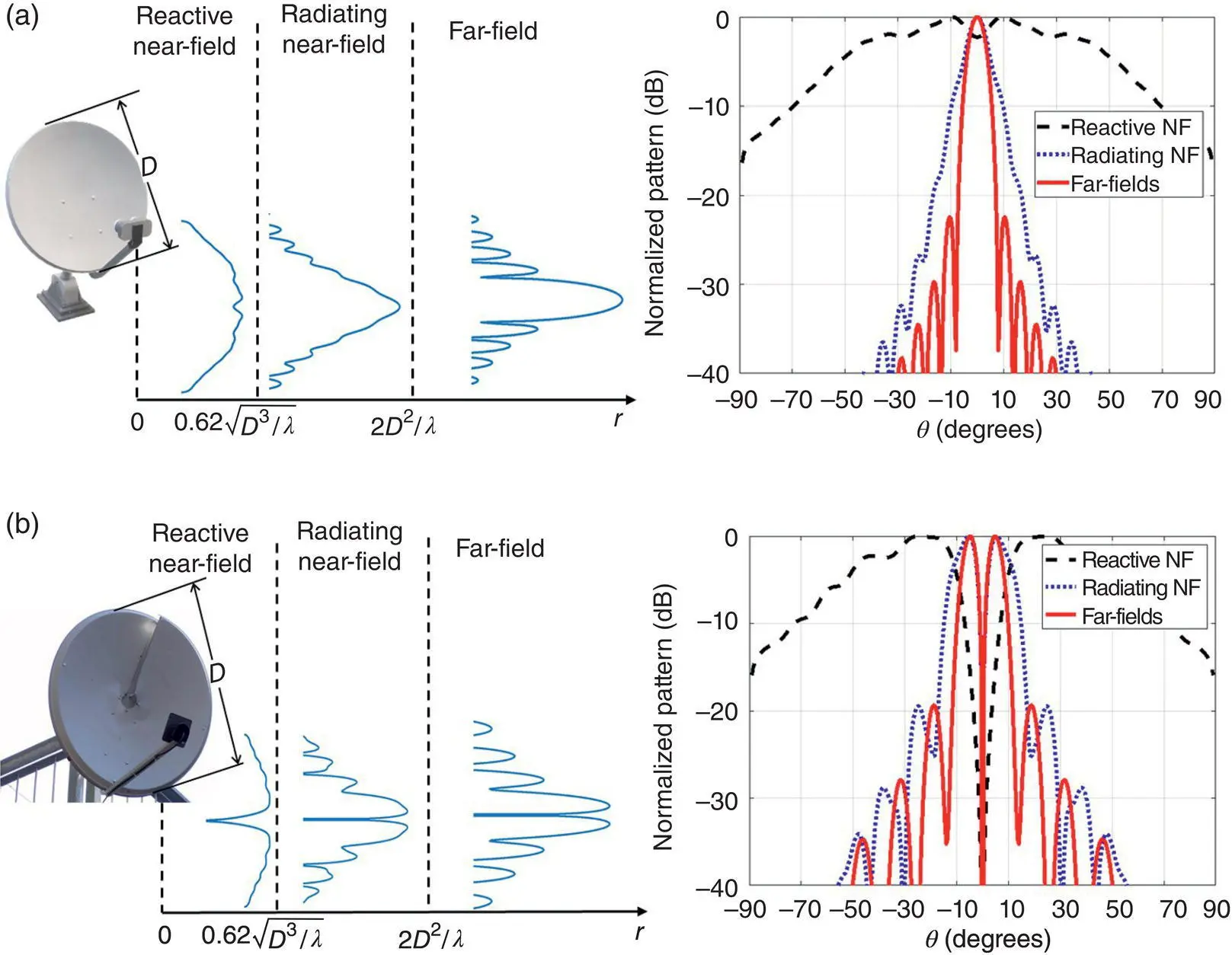
Figure 1.7 Changes of amplitude pattern shape from the reactive near‐field toward the far‐field for (a) a conventional antenna and (b) an OAM antenna. The dimensions are D = 10λ and the pattern is calculated at r = 4.9λ, 24λ, 8000λ corresponding to the reactive near‐field, radiating near‐field and far‐field regions.
1.3.1 OAM Communication Link Scenarios and Technical Barriers
In general, there are two communication links that involve OAM antennas, as shown in Figure 1.8. In the first scenario, an OAM antenna establishes a communication channel with a conventional antenna (the OAM antenna can be transmitting or receiving signals). This case is no different than the classical counterpart, where two conventional antennas are utilized. The link budget is calculated using the classical Friis transmission formula based on the directional properties, distance in terms of wavelength, and orientation of the antennas [26]:
(1.14) 
where P Rand P Tare the received and transmitted powers, respectively, λ is the operating wavelength, d represents the link distance, G T( θ t, ϕ t), G R( θ r, ϕ r) correspond to the gains along the transmitting T and receiving R antennas direction; antennas polarization mismatch is neglected for simplicity. The figure of merit of this communication link is the received power (i.e., signal‐to‐noise ratio) at the antenna terminals.
Читать дальше
